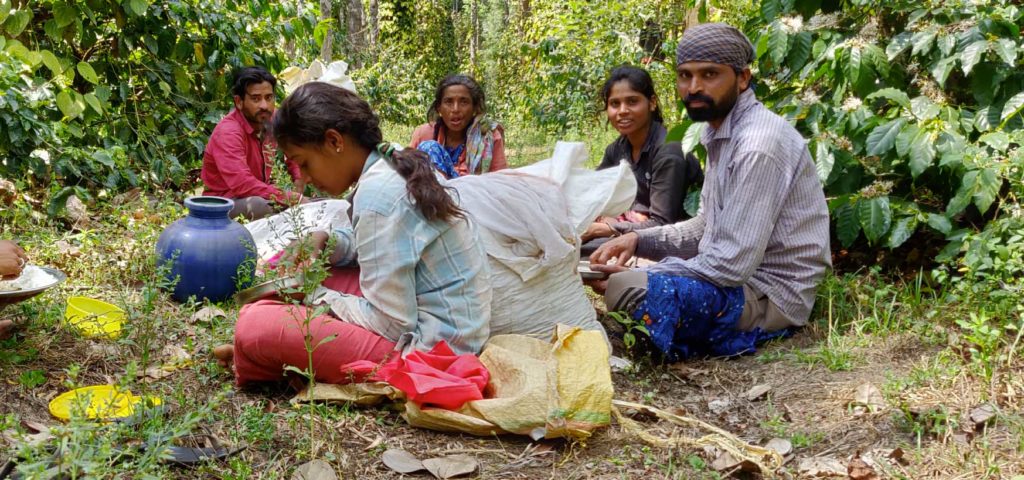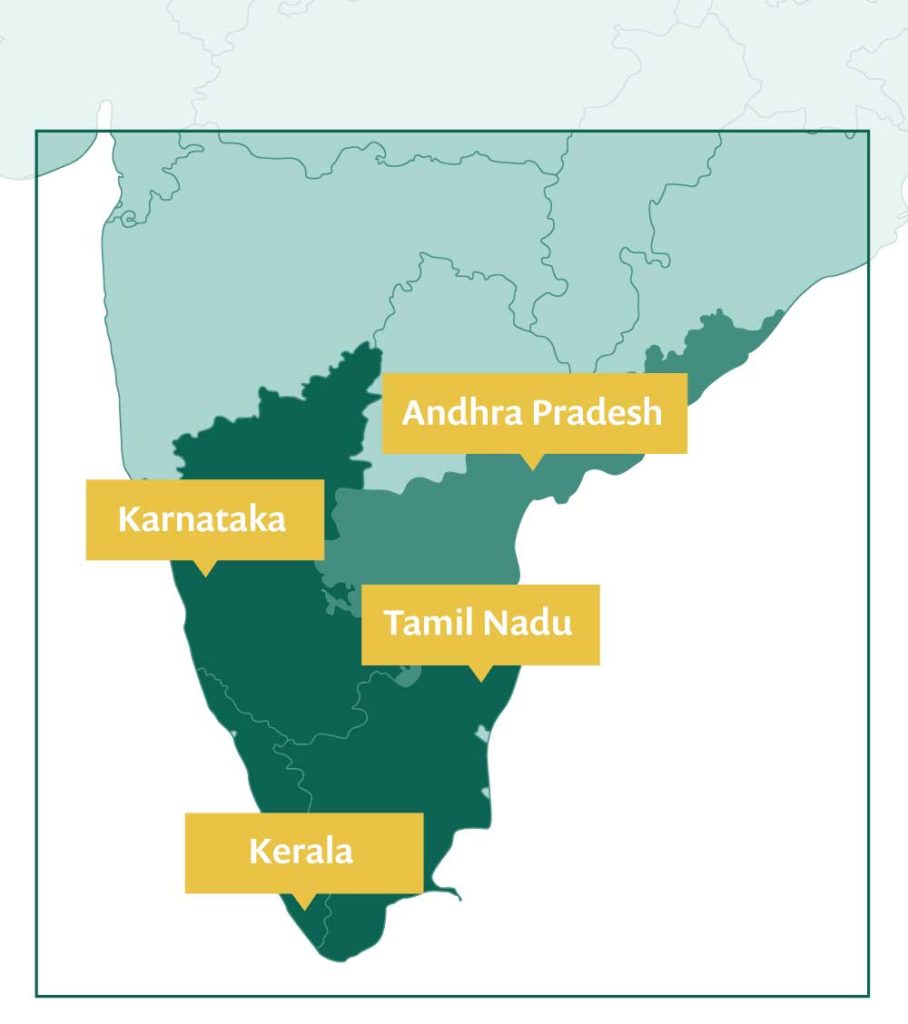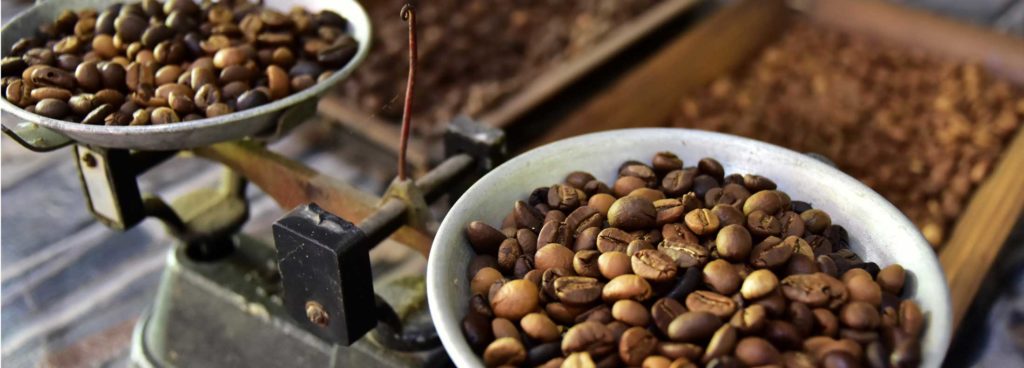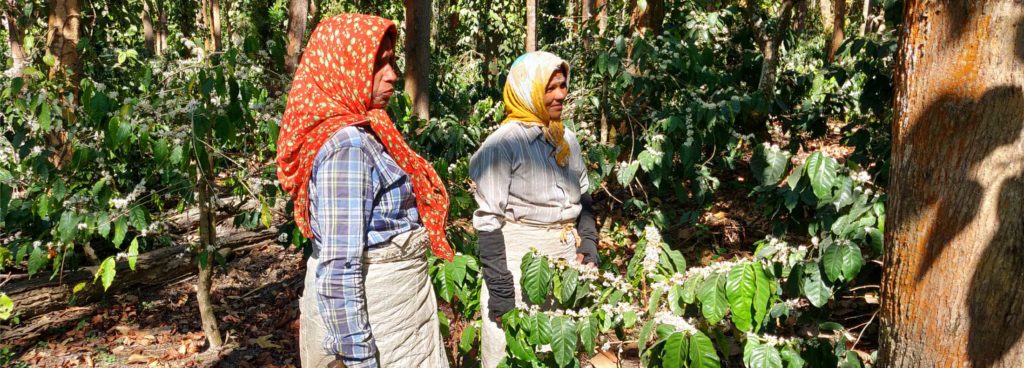Precision Development (PxD) has completed a landscape analysis to more systematically understand the challenges faced by users of the Coffee Krishi Taranga (CKT) service, with a focus on three core areas, namely, sustainability, market linkages, and gender. This work was funded by a grant from the Walmart Foundation.
As part of the landscape analysis, we conducted multiple rounds of farmer interviews, an extensive review of the literature, an analysis of our existing farmer database, and interviews with sectoral experts. In this blog, we share some key findings and information about what we’re looking to do next.

Coffee Krishi Taranga
Since August 2018, PxD has partnered with the Coffee Board of India to provide the CKT service to coffee growers. The CKT service is modeled on PxD’s flagship two-way Interactive Voice Response (IVR) service, which comprises an outgoing service that provides regular advisory to growers on their mobile phones and an inbound hotline that farmers can call to access free information services, including market-related information, and leave messages to be answered by agronomists. As of April 2022, the CKT services approximately 74,000 coffee growers across the states of Karnataka, Tamil Nadu, and Kerala. The team plans to expand the reach of the service to growers in Andhra Pradesh soon.

Key findings
Sustainability
Coffee growers in India face multiple risks linked to weather unpredictability, a challenge that has been exacerbated by climate change. Coffee is a sensitive crop, and heat and rainfall are widely considered to be the two most important factors for coffee growth1Haggar, J. and Schepp, K. (2012). Coffee and Climate Change Impacts and options for adaptation in Brazil, Guatemala, Tanzania and Vietnam. National Resources Institute Working Paper Series: Climate Change, Agriculture and Natural Resources, [online] No. 4, pp.1–50. Available at: https://www.nri.org/publications/working-paper-series/4-coffee-and-climate-change/file [Accessed 14 Sep. 2021].. In farmer interviews conducted in September 2021, 92% of farmers (N=83) said they had faced a weather-related challenge in the past year2Haggar, J. and Schepp, K. (2012). Coffee and Climate Change Impacts and options for adaptation in Brazil, Guatemala, Tanzania and Vietnam. National Resources Institute Working Paper Series: Climate Change, Agriculture and Natural Resources, [online] No. 4, pp.1–50. Available at: https://www.nri.org/publications/working-paper-series/4-coffee-and-climate-change/file [Accessed 14 Sep. 2021].. Weather can negatively impact the cultivation of coffee in a variety of ways, including crop damage at sensitive times such as blooming3Pokiya, T. (2021). Interview: Agronomist, PxD. 16 Jun. , increased incidence of pests and disease, increased soil erosion, and more.
What are we doing?
One obvious solution to mitigate the risks of weather variability is weather forecasts, in particular providing customized weather forecasts or real-time weather information, potentially coupled with relevant agronomic recommendations. However, access to high-quality forecasts is limited. In our farmer interviews, only 16% (N=73) said they have access to forecasts4 Krishi Taranga coffee growers (2021). Qualitative farmer surveys: Round 5. 24 Sep.. Our team is currently in the process of putting together a pilot to test the impact of providing customized weather forecasts on key agricultural practices (if you’re interested in learning more about PxD’s weather-related learnings, check out this recent series of blogs).
“The weather imbalance leads to severe black rot and we cannot use spray at the right time.”
Interview with D.S. Sathish, Basrikatte, Chikmagalur
The increase in average temperature and erratic rainfall also exacerbates risks associated with certain pests5 Watts, C. (2016). A Brewing Storm: The climate change risks to coffee. [online] The Climate Institute, pp.1–14. Available at: https://www.juntospelaagua.com.br/wp-content/uploads/2016/09/Pesquisa-sobre-caf—The-Climate-Institute.pdf [Accessed 14 Sep. 2021].. The impact of climate change on pests varies, but overall heavy rain and warmer temperatures are likely to increase the conditions in which several pests thrive. These pests can cause varying levels of damage — some can be devastating, resulting in crop losses of up to 70% if not treated timeously and effectively.6Machenahalli, S., Ranjini, A. P., Madhu S., Giri, Sudha M., Daivasikamani, S. and Surya Prakash Rao N. (2019). Disease of Coffee during monsoon season and their management. [online] Planter’s World, May, pp.4–7. Available at: https://krishi.icar.gov.in/jspui/bitstream/123456789/23682/1/coffee%20disease%20during%20monsoon.pdf [Accessed 14 Sep. 2021].
To explore ways to provide more targeted and actionable recommendations for pest management, we ran an A/B test in November 2021 that looked at the impact of sending multiple reminders on farmers’ knowledge and adoption of high impact practices. We focused on the treatment of white stem borer, an increasingly common pest for coffee growers in India. The results from this test will be shared shortly!

Markets
Smallholder coffee growers sell their produce in fragmented and exploitative local markets. A survey from Chikmagalur and Hassan districts (Karnataka) found that over 90% of growers sold their produce at the farm gate7 Babu, P. (2019). Value Chain Upgrading Strategies for Integration of Indian Small Coffee Growers in Global Coffee Value Chain. Economic Affairs, 64(4).. In our interviews, we found approximately 50% of farmers (N=140) sell their coffee to local traders or markets8Krishi Taranga coffee growers (2021). Qualitative farmer surveys: Round 1. 6 Jul.. There are several reasons why these selling conditions are less than ideal. This includes a lack of infrastructure: smallholders, who deal with relatively small amounts of coffee, usually sell directly to a local trader or agent who pays them on the spot and bears the costs of transporting the coffee to the curing agent. This is where smallholders often lose value on their coffee as local traders set the price for the farmers’ produce.
Another concern is high price variability and lack of transparency. Local traders set coffee prices according to international coffee trends. When buying from farmers on the ground, this price is adjusted based on the quality of the product, which is measured by moisture and out-turn tests. However, the degree to which prices are adjusted based on these metrics is not always clear, leaving farmers feeling frustrated.
“Traders will not buy coffee at existing coffee prices. When traders provide information about prices [they say] it will be more, but [when it comes to] selling the coffee, traders fix a certain [lower] rate and give the unnecessary reason that the moisture content is not good.”
Interview with A.G Nannaiah, Virajpete, near Madikeri

What are we doing?
As part of the CKT hotline, we offer a free price feature which farmers access to listen to daily local and international price information. This is our most used feature, indicating interest in price information. However, overall usage of the hotline is low. We are currently exploring alternative ways of delivering price information to our farmer base, in the hope of reducing frictions and increasing the use of market price tools and information. Lines of relevant inquiry include exploring the use of WhatsApp and SMS to provide price alerts.
To explore ways of reducing price variability, which contributes to income volatility and uncertainty, the PxD team is running a market linkages pilot with the Sustainable Trade Initiative (IDH) in Karnataka. IDH will facilitate contracts between interested buyers and smallholder growers, in which buyers commit to purchasing produce (granted it meets certain quality conditions) at a fixed price. PxD will support growers in meeting these conditions by disseminating relevant agricultural information.
Gender
“My wife visits the estate whenever it is necessary, for example if I am away from the station she looks after things, and after the harvest and the coffee is dried, she weighs it and keeps a record of the quantity of coffee available after it has dried.”
Interview with Virajpete Madhayya, Madikeri
As per India’s Census 2011, coffee plantations were major employers of women workers in Karnataka; out of a total of 480,000 average daily workers employed in coffee plantations, 62% were women. Women appear to be employed for specific activities such as coffee picking, weed management, and applying manure and chemical fertilizers 9Joy, C.V. (2004). Small Coffee Growers of Sulthan Bathery, Wayanad Kerala Research Programme on Local Level Development Centre for Development Studies Thiruvananthapuram. [online] Centre for Development Studies, Kerala, India: Centre for Development Studies, pp.1–43. Available at: http://www.cds.ac.in/krpcds/publication/downloads/83.pdf [Accessed 29 Oct. 2021].. In our interviews with women, we found that women are heavily involved in specific coffee-related activities, including weeding and coffee picking. While women are generally not primary decision-makers for most activities, they appear to be included in the decision-making process. We also learned that women are often part of community groups including self-help groups like “Swasahaya Sangha” (for more information, see our blog post on women’s groups).
What are we doing?
We would like to explore the role of women’s groups and whether these can be leveraged to increase engagement with, and provide relevant support to, female farmers. Evidence from our other programs and the literature suggests that women can increase their collective knowledge and engagement through participating in community groups. The fact that many women in our service are generally involved in day-to-day decision-making suggests that there is room to cater specifically to the areas in which women work. This includes exploring value chains adjacent to coffee cultivation where women may have more involvement, for example, intercrops like spices.
Looking forward
The landscape analysis helped our team gain a broader understanding of the range of challenges and opportunities that exist within the coffee sector in Southern India. In doing so, we have been able to strategize and set evidence-based priorities. This includes focusing on addressing weather-related risks through a pilot to test the impact of providing customized weather forecasts to coffee growers, and a market-focused pilot with IDH.
At the same time, we are also scaling our program with the support of the Walmart Foundation. This includes expanding to another coffee-growing state, Andhra Pradesh. Coffee growers in Andhra Pradesh are different from those in Karnataka, as they are primarily based in tribal regions and practice more traditional farming. We are excited to learn more about coffee growers in this region and adapt our existing service to address their unique information needs.


Stay Updated with Our Newsletter

Make an Impact Today


